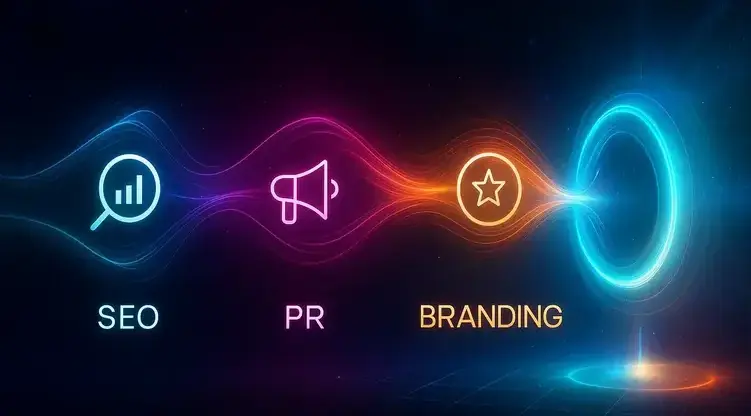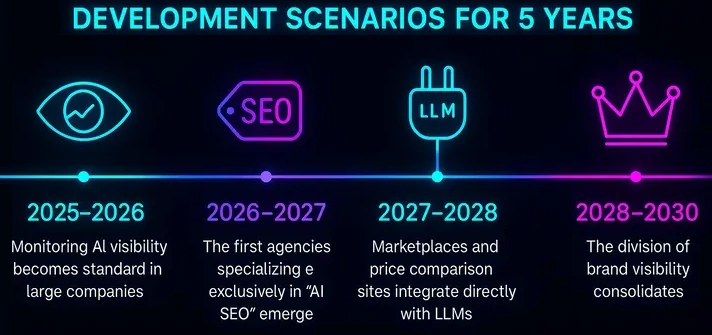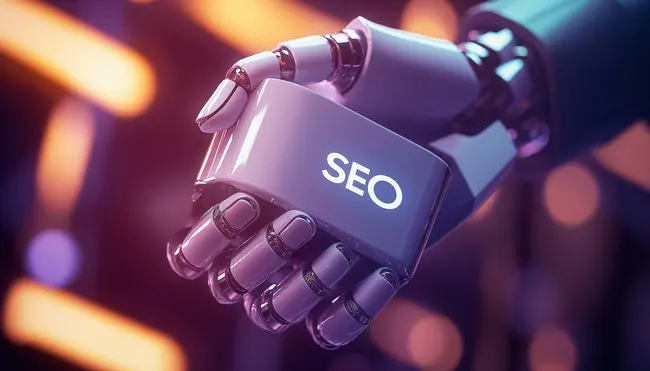The future of SEO in the era of AI-first search: how the approach to SEO will evolve in the coming years

Introduction
Traditional SEO, based on keyword optimization, link structure and the technical aspects of websites, is becoming insufficient. As the role of generative artificial intelligence grows, especially language models (LLMs) such as GPT, Gemini or Claude, the information search process increasingly bypasses classic search engines. Instead of typing phrases into Google, users ask AI assistants directly, which provide a ready answer - often a single best answer rather than a list of results. This is a fundamental change: from the search engine results page (SERP) we move to the single best answer, and SEO strategies must adapt.
The end of keyword-based SEO
In classic SEO keywords were the foundation - content was optimized to match particular queries. But AI does not operate by simple matching. Language models understand user intent, not just a string of characters. Example: a user types into Google "best smartphone 2025". In traditional SEO it was important that the text contained that phrase and links. In AI-first search the model analyzes context: user preferences, prior interactions, product data integrated via API and media reviews. The result no longer depends on keyword density in the text but on semantic matching and brand credibility. This means the end of keyword stuffing and the need to build holistic content that answers real questions and needs.
Personalization and context as new pillars of visibility
One of the biggest advantages of AI-first search is personalization. Each user receives an answer tailored to their profile: search history, location, shopping preferences or even the tone they use in questions. Consequences for brands:
- - One universal piece of content is not enough. Multivariant narratives are needed to suit different contexts (e.g., a premium customer vs. a customer seeking an economical solution).
- - Brands must manage consistency across many touchpoints - website, social media, reviews, product data. AI gathers information from the entire ecosystem, and inconsistency can weaken visibility.
New KPIs in the AI-first search world
Traditional SEO metrics - SERP position, number of links, CTR - lose significance. They are replaced by indicators specific to the AI world:
- - AI Share of Voice (AI SoV) - the percentage share of a brand in AI-generated answers within a given category.
- - AI Sentiment Visibility (AI SV) - how AI describes the brand: positively, neutrally or negatively.
- - AI Recommendation Rate (AI RR) - how often the model recommends a brand’s products or services relative to competitors.
Companies will need to learn to measure these metrics, report them to management and use them as the basis for marketing decisions. Just as in the 2000s the key report was the "Google ranking", in 2025–2030 it will be the AI visibility report.
Fusion of SEO, PR and branding

In the era of classic Google SEO and PR, they operated alongside each other - SEO handled search visibility, PR handled media reputation. In the AI-first search world those boundaries blur. Language models do not look only at links or site structure but analyze context, sources, citations and brand reputation. Therefore, building visibility in AI requires close synergy between SEO specialists, PR departments and branding teams.
The end of link building dominance
For years the foundation of SEO was acquiring links to a site - the more and the more valuable, the better for Google ranking. But in the AI-first world:
- - links lose weight - language models do not "read" the web like Google bots, but analyze huge corpora of content and trusted sources,
- - what becomes more important is citing the brand in an expert context, e.g., in trade media, reports or academic publications,
- - AI evaluates reputation holistically - a link may not be considered at all if the source is not regarded as authoritative.
Citations and reputation as the new PageRank
One could say that in AI-first search "PageRank" becomes a brand’s authority in narratives. Models more often recommend entities that:
- - appear in opinion-leading media articles,
- - are cited by experts and opinion leaders,
- - have a consistent image across channels.
Example: if a fintech brand is regularly mentioned in reports by PwC or Deloitte, AI will treat it as more credible than a startup mentioned only on local blogs.
Collaboration of SEO, PR and content marketing
In the new ecosystem SEO, PR and content marketing cannot exist separately. Instead of separate strategies, a single coherent stream of brand narrative emerges that:
- - has an SEO specialist ensuring content is semantically aligned and readable for AI,
- - has a PR professional building media presence and industry authority,
- - has a branding team ensuring consistency of message and tone of communication.
Only such an approach allows AI to perceive the brand as credible and recommendable.
Multichannel narratives
AI pulls data from many sources - websites, social media, podcasts, video, discussion forums. This means the brand must ensure consistent narratives across all channels. Discrepancies between messages (e.g., the brand presents itself as premium on social media, while reviews say low quality) can lead to a decrease in AI Sentiment Visibility.
Automation and new tools
In the AI-first search era SEO cannot be conducted exclusively manually. The scale of data, variability of results and the dynamic development of language models make automation the foundation of the new SEO practice. In the coming years the market will be dominated by solutions that monitor brand visibility in LLM responses and support content creation with regard to how AI interprets it.
Monitoring visibility in LLMs
Classic SEO tools (Ahrefs, Semrush, Senuto) measure visibility in Google. Meanwhile AI-first search requires tools that will show:
- - how often a brand appears in AI model responses,
- - in what context it is described (tone, sentiment, comparisons with competitors),
- - which products or services are recommended.
Examples include systems like BrandInAI, ChatBeat, which analyze responses from language models (ChatGPT, Gemini, Claude) and build AI Share of Voice reports. This is a new form of ranking that will become as fundamental as today’s Google visibility reports.
SEO-as-a-service and content recommendations
AI also changes how companies optimize content. Next-generation tools will act like a continuous SEO consultant, automatically suggesting:
- - what content to add so AI mentions the brand more often,
- - how to change tone to improve AI Sentiment Visibility,
- - which product data need to be structured and exposed to increase AI Recommendation Rate.
We may speak of the birth of the "SEO-as-a-service" model - platforms operating in the background that monitor, analyze and suggest continuous fixes, eliminating the manual SEO audits we know today.
Product data integrations via API
In the AI-first search world how brands expose their data will be crucial.
- - E-commerce - stores will integrate product catalogs with LLMs via API so their offers can be directly recommended. If a customer asks the assistant: "Recommend running shoes up to 200 EUR", the model will not base its answer on the Google index but on current product data provided directly by the manufacturer or marketplace.
- - Travel - hotel chains and airlines are already testing integrations that allow AI to point to specific offers available in real time.
- - Finance - banks and fintechs provide data on interest rates, loan conditions or cards so AI can suggest the best solution based on up-to-date information.
This process will make APIs a new SEO channel. Lack of integration will mean absence from AI recommendations.
Automation of competitive analysis
New tools will also enable tracking how AI recommends competitors. Example questions that will be possible to monitor:
- - Does my brand appear more often than competitors in AI responses?
- - In what context does AI talk about my products vs. competitors’?
- - Does AI point to my offer as better in terms of price, quality or availability?
This will open a new area of "AI competitive intelligence", where brands can react almost in real time to changes in perception of their brand.
AI development and evolution of conversational assistants
One of the key drivers of change in SEO will be not only the transformation of language models themselves but also the dynamic development of AI assistants. Today’s ChatGPT, Gemini, Copilot or Claude are still relatively "general" and require users to actively formulate queries. However, in the next 3–5 years we can expect the emergence of specialized, contextual AI assistants that will inspire greater trust and ease of use for users, and thus replace classic search engines in many areas of life.
- - Shopping assistants - recommending products directly in conversation, integrated with e-commerce platforms via API.
- - Travel assistants - planning an entire trip (flights, hotels, attractions) eliminating the need to visit search engines or price comparison sites.
- - Financial assistants - analyzing users’ personal data and suggesting the best credit, investment or insurance offers.
- - B2B assistants - supporting procurement processes in companies, condensing the entire customer journey into a single recommendation.
This change means the user’s touchpoint with the brand will shift from the search engine to a conversational AI agent. Instead of "ranking in Google", brands will need to build visibility in assistant models that have broader context and deeper understanding of user needs. With the evolution of AI assistants an ecosystem of micro-markets of recommendations will also emerge, where brands will compete to become the default answer to a customer’s question. This will radically change the SEO landscape - from vying for a place in the SERP to vying for priority in conversational agent recommendations.
The "winner takes all" effect

One of the most fundamental differences between classic SEO and AI-first search is the change in how results are presented. In Google the user saw a list of 10 organic results on the first page (plus ads and enhanced elements), which gave many brands a chance of visibility. In AI-first search the situation is completely different: the user receives one, at most a few recommendations. This creates a "winner takes all" effect - the brand that appears in the AI answer gains a huge advantage, and those not mentioned practically disappear from the customer’s view.
Why dominance of a few brands is more likely in AI?
- - AI minimizes choice - its role is to simplify the decision process, so it points to 1–3 best options instead of 10 or 20 results.
- - Language models reward credibility - the more often a brand appears in trusted sources, the higher the chance it will be considered a "safe recommendation".
- - Risk of AI responsibility - models avoid recommending weak or controversial brands to not mislead users. This strengthens the largest and most stable players.
- - API integrations - companies that integrate their data with AI assistants faster will be chosen by default, pushing competitors into the shadows.
Examples of industries most at risk
- - Travel - the question "Recommend a family-friendly hotel in Barcelona" may end with 1–2 properties suggested. If your brand isn't there, the user will never learn about it.
- - E-commerce - queries like "Best running shoes up to 200 EUR" may result in only two brands being recommended, even though hundreds exist on the market.
- - Finance - an AI assistant may recommend one credit card or one savings account as "the best", while other institutions remain invisible.
- - Healthcare and medtech - AI recommendations about OTC drugs, supplements or clinics may concentrate user attention on several global players.
- - Software & SaaS - in B2B, queries about "the best CRM for small businesses" may promote only 1–2 tools, eliminating a long list of smaller providers.
Business consequences
- - Market polarization - large players that first invest in AI visibility may gain an almost monopoly-like attention.
- - Marginalization of medium and small companies - lack of presence in AI recommendations means invisibility, even if the offer is competitive.
- - Price and partnership pressure - brands may be forced to integrate with large marketplaces or partner platforms to "enter the AI recommendation ecosystem".
- - Change of marketing models - advertising budgets may shift from traditional campaigns to activities that build authority and visibility in AI.
How to protect yourself from disappearing from recommendations?
- - Build strong authority - invest in PR, expert citations and thought leadership content so AI recognizes your brand as credible.
- - Integrate data via API - without this you won’t appear in transactional recommendations.
- - Monitor AI visibility - track AI Share of Voice and AI Recommendation Rate to know how your position is changing.
- - Diversify touchpoints - besides AI-first search invest in community, social media and direct customer channels.
- - Prepare "what if" scenarios - in some industries lack of AI presence may require changing the business model (e.g., from direct sales to partner-based).
Simulation of the "winner takes all" effect
Imagine a credit card market in a given country with 15 active banks. In Google a user typing "best credit card 2025" will see 10 links - each bank has a chance for visibility. In AI-first search the AI assistant replies: "The best credit cards are X and Y - they offer the best conditions and the most benefits." Effect: 13 banks become invisible. Even if they have competitive offers, the customer will not see them because AI provided a ready recommendation. This is the essence of the "winner takes all" effect.
Development scenarios for 5 years
Below is a realistic 5 year trajectory: from standardizing AI visibility monitoring and AI Share-of-Voice reporting, through the rise of dedicated "AI SEO" agencies, to marketplaces integrating directly with LLMs-and, ultimately, a concentrated landscape where a few brands dominate AI answers.
2025–2026: Monitoring AI visibility becomes standard in large companies. AI SoV reports land on CMOs’ desks.
2026–2027: The first agencies specializing exclusively in "AI SEO" emerge.
2027–2028: Marketplaces and price comparison sites integrate directly with LLMs so their offers can be automatically recommended.
2028–2030: The division of brand visibility consolidates - leaders enter a phase of almost monopolistic presence in AI responses.

Summary and recommendations
The world of SEO is entering a new era - AI-first search is changing the rules faster than it did in Google’s early days. Classic metrics (rankings, links, CTR) give way to new metrics: AI Share of Voice, AI Sentiment Visibility, AI Recommendation Rate. History repeats itself. In the early 2000s companies that quickly understood the importance of SEO and began investing in Google optimization gained a huge advantage. Those that missed the moment had a much harder time later. Today we are in a similar situation: the game now includes not only search engines but increasingly capable AI assistants that gradually replace Google as the first source of information and recommendations. The stake is visibility in the AI-first search world. Key actions for brands in 2025:
- - Start monitoring AI visibility - know how the brand is described and recommended.
- - Build authority - through PR, expert publications and consistent branding.
- - Automate content - use tools that analyze visibility in LLMs and adapt content.
- - Think long-term - prepare for a scenario where only a few brands in a given industry dominate AI recommendations.
The "winner takes all" effect means visibility will benefit only a few brands - the rest will become invisible. Therefore companies must already:
- - Monitor their presence in AI,
- - Build expert authority,
- - Expose product/service data via API,
- - Combine SEO, PR and branding into a single process.
Just as in the 2000s rapid adoption of SEO decided success, in 2025–2030 the winner will be the one who early on secures visibility in AI-first search.
If you want to start influencing how your brand is presented in search results right now, use our tool BrandInAI, which will let you check how your company ranks in LLMs - something along those lines.

